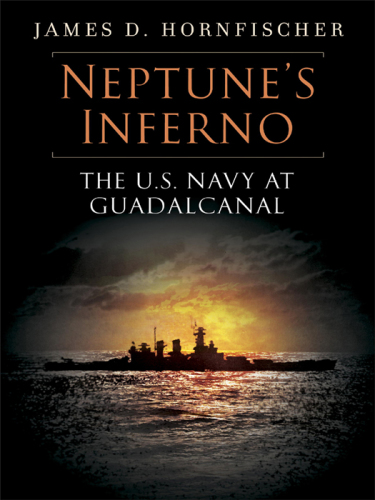
Neptune's Inferno
The U.S. Navy at Guadalcanal
کتاب های مرتبط
- اطلاعات
- نقد و بررسی
- دیدگاه کاربران
نقد و بررسی

December 6, 2010
Hornfischer (Ship of Ghosts) understands the human dynamics of the U.S. Navy in the Pacific war as well as any student of the subject. Here he focuses on the period when the Navy underwent its sternest test. The struggle for Guadalcanal, he writes, was "the most sustained and vicious fight of the Pacific war." It featured seven major naval actions and required the Navy to master a new kind of war: it was the first of the amphibious expeditionary campaigns charcteristic of the Pacific theater, combining air, land, and sea forces,and the U.S. was spectacularly unprepared to cope with its demands. Nor did the U.S. understand as yet how effective its Japanese opponent was—eventually, this knowledge was purchased with blood, and Hornfischer gives an empathetic but balanced account of that process. He reconstructs the fighting in a masterful synthesis of technical analysis, operational narrative, and tales of courage. His listing of one set of commendations submitted by one ship after one action stands in particular for all "the men without rank" who made up for the shortcomings of ship designers, admirals, and captains in the waters of Ironbottom Sound. 16 pages of b&w photos, 9 maps.

October 1, 2010
Hornfischer (Ship of Ghosts: The Story of the USS Houston, FDR's Legendary Lost Cruiser, and the Epic Saga of Her Survivors, 2006, etc.) chronicles the World War II Pacific campaign to capture and hold Guadalcanal from the Japanese.
The battles were remarkable, and the author is at his best when he lets the story unfold on its own. The campaign began in August 1942 when 16,000 Marines were dispatched to capture a landing field the Japanese were constructing that would enable aircraft to control a radius of 500 strategic miles of the South Pacific. Loss of the airfield would expose the Navy to Japanese air attacks throughout the region; its capture would enable the Allies to protect the routes and, moreover, attack the Japanese entrenched in New Guinea. The Marines routed the Japanese, but the Navy, attacked at night by Japanese cruisers, lost four ships and withdrew. Afterward, between August and December, in a series of brutal naval engagements, the Japanese navy landed soldiers on Guadalcanal to retake the field and destroyed American and Australian aircraft carriers, cruisers and destroyers. However, the U.S. Navy shocked the Japanese with its own night attacks and the use of SG radar to sink Japanese battleships and surface craft of all kind, ultimately leading to the loss of nearly 40 Japanese ships and the death of more than half of all Japanese aviators who had participated in the attacks on Pearl Harbor. With painstaking research and an intimate sense of tragedy, Hornfischer relates how failed communications, erroneous orders, loss of nerve and unwillingness to trust radar led many American ships directly into the sights of Japanese arms. The outcome was in doubt until the Japanese withdrew in February 1943. The horror of the flagship San Francisco shelling its own fleet not once, but twice, and the abandonment of the crew of the torpedoed Juneau to die in shark-infested waters are among the wrenching tales that need few adjectives to engage readers. Unfortunately, the author often stretches and provides too many descriptors, intruding on a story that is riveting in its own right.
Sure to please military and WWII buffs, but may leave others unsatisfied.
(COPYRIGHT (2010) KIRKUS REVIEWS/NIELSEN BUSINESS MEDIA, INC. ALL RIGHTS RESERVED.)

March 15, 2011
During the Battle of Guadalcanal, which extended from August 1942 into early 1943, the U.S. Marines grimly staved off loss on three of the Solomon Islands while the U.S. Navy and Imperial Japanese Navy fought in surrounding waters. The Japanese had better planes, torpedoes, and night fighting tactics. Naval historian Hornfischer (Ship of Ghosts) emphasizes the individual experiences of officers and enlisted men to humanize his exciting account. The night surface actions were particularly deadly, as the participants' descriptions of the smoke and confusion of intense gunnery actions show. Losses were fairly even, but the Japanese eventually evacuated Guadalcanal. With good maps and extensive documentation, this is gripping and readable, not a dry military report. Recommended for general World War II history buffs.
Copyright 2011 Library Journal, LLC Used with permission.

Starred review from December 1, 2010
Hornfischers third outstanding book on the U.S. Navys surface forces in WWII will have a ready-made audience because its subject is the naval side of the Guadalcanal campaign of 1942. The campaign began when marines landed on that deservedly unfrequented island to halt the creation of a Japanese airbase that might threaten U.S. communications with Australia. The Japanese riposte inflicted a disaster on the U.S. Navy second only to Pearl Harbor, called the Battle of Savo Island. Over the next few months, the two navies went at each other hammer and tongs in what was probably the most intense naval campaign of the war. The Japanese had an ace up their sleeve in the Long Lance torpedo, the best in the world. The U.S. eventually counterbalanced the Japanese by learning (all too slowly) to use radar-directed gunfire to take back the night seas. The author offers balanced assessments of the leaders on both sides, but the real heroes are the American bluejackets, who too often paid with suffering and death for those leaders slowness to learn. And as in his first two books, the authors narrative gifts and excellent choice of detail give an almost Homeric quality to the men who met on the sea in steel titans.(Reprinted with permission of Booklist, copyright 2010, American Library Association.)

























دیدگاه کاربران